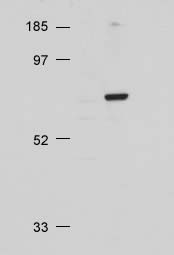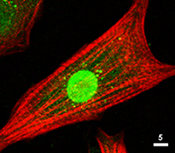Anti-AKT1+ AKT2 + AKT3 Rabbit mAb
Catalog number :AT0347
Plays a role as a key modulator of the AKT-mTOR signaling pathway controlling the tempo of the process of newborn neurons integration during adult neurogenesis, including correct neuron positioning, dendritic development and synapse formation (By similarity). General protein kinase capable of phosphorylating several known proteins. Phosphorylates TBC1D4. Signals downstream of phosphatidylinositol 3-kinase (PI(3)K) to mediate the effects of various growth factors such as platelet-derived growth factor (PDGF), epidermal growth factor (EGF), insulin and insulin-like growth factor I (IGF-I). Plays a role in glucose transport by mediating insulin-induced translocation of the GLUT4 glucose transporter to the cell surface. Mediates the antiapoptotic effects of IGF-I. Mediates insulin-stimulated protein synthesis by phosphorylating TSC2 at 'Ser-939' and 'Thr-1462', thereby activating mTORC1 signaling and leading to both phosphorylation of 4E-BP1 and in activation of RPS6KB1. Promotes glycogen synthesis by mediating the insulin-induced activation of glycogen synthase. The activated form can suppress FoxO gene transcription and promote cell cycle progression. Essential for the SPATA13-mediated regulation of cell migration and adhesion assembly and disassembly.
- Overview
- Description
- Rabbit monoclonal antibody to pan-AKT
- Reactivity
- Mouse, Rat, Human
- Tested applications
ICC : 1/80. IHC-P : 1/1000 - 1/1500. WB : 1/500. Detects a band of approximately 60 kDa (predicted molecular weight: 56 kDa). ICC/IF : Use at an assay dependent concentration.
- Properties
- Immunogen
Synthetic peptide: CRPHFPQFSYSASGTA conjugated to KLH, corresponding to amino acids 466-480 of Human pan-AKT (100% similar to Rat, Chicken and Mouse AKT sequences).
- Clonality
- Monoclonal, clone number: 5EA7
- Isotype
- IgG
- Form
- Liquid
pH: 7.20
Preservative: 0.1% Sodium azide
Constituents: 0.42% Potassium phosphate, 0.87% Sodium chloride
Note: 0.02M Potassium phosphate, 0.15M Sodium chloride
- Storage instruction
- Shipped at 4°C. Upon delivery aliquot and store at -20°C or -80°C. Avoid repeated freeze / thaw cycles.
- Applications
- WB Image

Western blot - pan-AKT antibody
The Akt antibody (AT0347) is used at 1/80 on cultured neonatal rat cardiomyocytes that express a nuclear-targeted Akt construct. The green is Akt antibody, the red is Texas-red™ phalloidin that labels actin filaments.
- IHC Image

Immunohistochemistry (Formalin/PFA-fixed paraffin-embedded sections) - pan-AKT antibody
A: Normal colon tissue
B: Tumour tissue
Akt antibody (AT0347) used at 1/1000 on formalin-fixed paraffin embedded tissue.
- ICC/IF Image

Immunocytochemistry/ Immunofluorescence - pan-AKT antibody
The Akt antibody (AT0347) is used at 1/80 on cultured neonatal rat cardiomyocytes that express a nuclear-targeted Akt construct. The green is Akt antibody, the red is Texas-red™ phalloidin that labels actin filaments.
Related Products
Reviews
loading...
 Run BLAST with
Run BLAST with 